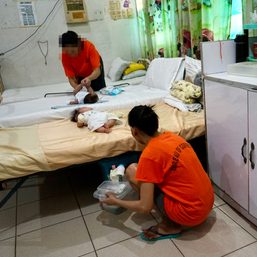SUMMARY
This is AI generated summarization, which may have errors. For context, always refer to the full article.
![[Rappler Investigates] What’s it all about, Alice?](https://www.rappler.com/tachyon/2024/05/alice-guo-newsletter-may-30-2024.jpg)
It’s been such an intriguing, made-for-Netflix type of story that, many probably found themselves glued to the Senate investigation into Alice Guo, the 37-year-old, first female mayor of the municipality of Bamban in Tarlac.
Senate investigations are commonplace, some of them politically motivated or just for show, producing no new legislation or policy changes. Such skepticism, however, was likely shelved when the swirling allegations that merited a probe centered on suspicions that Guo might be a Chinese spy who has successfully penetrated lower levels of the Philippine government. The suspicions were fanned by findings that triggered more questions than answers (READ: 5 things that don’t add up in Mayor Alice Guo’s Senate testimony), among them:
- how could a young, inexperienced hand in politics run as an independent and defeat (even if only by a narrow margin) a barangay captain affiliated with the entrenched Nationalist People’s Coalition, which she would later join?
- how could she spring out of nowhere, become mayor, claim to be an ordinary and simple citizen, yet own a bevy of vehicles and declare a net worth of up to hundreds of millions of pesos?
- how could she be impervious to illegal activities in a sprawling, 10-hectare compound of Philippine offshore gaming operator (POGO) Zun Yuan Technology Incorporated, also the site of over 30 multistory buildings recently raided by the Presidential Anti-Organized Crime Commission (PAOCC) – and just within spitting distance of the Bamban municipal hall?
- how could she not possibly have done due diligence on business partners Zhang Ruijin and Baoying Lin who were found to be linked to Singapore’s largest money laundering case?
The riveting twists and turns in the Alice Guo story are enough to perplex conspiracy theorists who are into espionage and crime. (WATCH: Newsbreak Chats: Untangling the mystery of Alice Guo) The revelations in the Senate come at a time when tensions are high between the Philippines and China over the West Philippine Sea. PAOCC investigators, however, say that the Chinese government has been working closely and cooperating with them in running after their own citizens who violate Chinese laws. Any form of gambling, whether online or overseas, is illegal, the Chinese embassy has said.
The Alice Guo case is only indicative of a bigger menace. The Philippine government flung its doors open to POGOs in hopes of boosting revenues.
Economic benefits reaped from POGOs amount to as high as P144.5 billion a year, according to 2022 data from the finance department. The National Economic and Development Authority, also in 2022, said that POGOs had contributed P53.1 billion, equivalent to about 0.31% of the gross domestic product. This is much lower, however, than 2019’s P104.5 billion, accounting for 0.67% of GDP.
Even in terms of tax collections, former finance secretary Maria Magno had said that in 2021, tax collections from POGOs reached P7.38 billion, already lower than the P12.46 billion collected in 2020, and even much lower compared to 2019’s P14.44 billion. Tax collections, however, improved in 2022. (READ: IN NUMBERS: Risks, benefits of POGO operations)

Philippine Amusement and Gaming Corporation (Pagcor) Chairman and CEO Alfredo Tengco remained optimistic in July last year, saying in a GMA report that their projections indicated gross gaming revenues reaching P24 billion by year-end 2023. The number of registered POGOs is, however, on the decline – down to 32 (as of 2023) from pre-pandemic levels of 281 in 2019.
The problem with hitching the Philippine economic wagon to POGOs is that it’s neither stable nor sustainable. But a fast buck is always hard to resist.
This is also probably why Alice Guo – assuming she is legitimate through and through – chose to ignore in her own backyard the imposing POGO structures that had been for several years the site of illegal, criminal activities.
At the municipal level, a letter of no objection (LONO) – among the requirements of Pagcor for a license application – can reportedly be had in exchange for hundreds of thousands of pesos. Councilors can be persuaded to cooperate and pose no objections to the issuance of a LONO allegedly in exchange for tens of thousands of pesos. In other words, pera-pera lang (all about money). It would be interesting to map where in the Philippines these POGOs are concentrated. This is not to say that local government units in these areas are all complicit or that all POGOs engage in human trafficking, love scams, and what-have-you. A map could help officials monitor activities and make sure they are all aboveboard.
Leaders who want to ensure that the Philippines’ reputation and standing are not tarnished by association with cross-border criminal activities need to look at the network of agencies involved in the issuance of permits and documents that enable illegals to operate via POGOs and their reincarnations: LGUs, immigration, consular services, the Department of Foreign Affairs, Philippine National Police, Department of Justice. It’s an entire bureaucracy that can suddenly turn vulnerable and be seduced by money.
PASIG RIVER WOES. Another long-running and highly visible problem that has been staring Malacañang in the face for many, many years is pollution in the Pasig River. Environment reporter Iya Gozum pointed out that efforts to save the 26-kilometer river that snakes through Metro Manila have been going on for about half a century already with little success.
Former president Rodrigo Duterte was correct in saying that such efforts would be futile unless government effectively dealt with the source of the problem – every building, every person who has waste “going down in a sewage or sewerage.” The fecal coliform count near the Delpan Bridge in Manila, for instance, registered way above the acceptable standard of 200 MPN/100 milliliters. MPN stands for “most probable number.” What was Delpan’s fecal coliform count in 2021? 17 million.
Besides human waste, there’s industrial and chemical waste from factories that line the Pasig River and trash from communities along esteros.
The Pasig River baton has been passed from one president to the next, starting with Ferdinand E. Marcos and now in the hands of his son and namesake, Ferdinand Jr. His wife Liza has her own vision for the river, as did first ladies before her. As we have seen through the years, superficial fixes really won’t do the trick in effectively flushing all the waste from the river.
STATE OF PRISONS. Duterte certainly left his mark even after his term as president. Our prison population has ballooned beyond the 100,000 mark, with drug cases accounting for 7 out of 10 involving persons deprived of liberty. Below 100,000, the congestion rate already hit 411%, according to reporting by Lian Buan and Patrick Cruz.
As a result of the war on drugs, the congestion rate in the Bureau of Jail Management and Penology has soared to 600%. Imagine how at below a population of 100,000, 41 detainees could share a cell meant for only 10. And it’s worse today. Read more about prison conditions in this two-part series:
- Duterte’s drug war pushes prisons to a breaking point
- Philippines only starting to probe ‘silent tragedy’ of prison deaths
– Rappler.com
Rappler Investigates is a bimonthly newsletter of our top picks delivered straight to your inbox every other Thursday.
To subscribe, visit rappler.com/profile and click the Newsletters tab. You need a Rappler account and you must log in to manage your newsletter subscriptions.
Add a comment
How does this make you feel?



![[Be The Good] PAREX and the power of communities](https://www.rappler.com/tachyon/2024/03/parex-protest-newsletter-mar-21-2024.jpg?resize=257%2C257&crop=275px%2C0px%2C720px%2C720px)

![[EDITORIAL] Ang ‘deep, deadly web’ ng POGOs](https://www.rappler.com/tachyon/2024/07/animated-pogos-chinese-crime-syndicate-carousel.jpg?resize=257%2C257&crop=280px%2C0px%2C720px%2C720px)






![[OPINION] Drug arrest and jail and prison congestion: Search for alternatives](https://www.rappler.com/tachyon/2023/12/tl-drugs-prison.jpg?resize=257%2C257&crop=391px%2C0px%2C1080px%2C1080px)
![[Rappler Investigates] The POGO mysteries](https://www.rappler.com/tachyon/2024/06/rappler-investigatives-pogo-mysteries-June-13-2024.jpg?resize=257%2C257&crop_strategy=attention)

There are no comments yet. Add your comment to start the conversation.